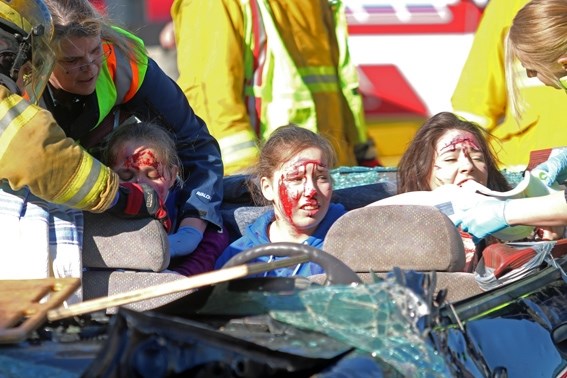Students from all over Bonnyville learned a sobering lesson at the second annual Bonnyville Safe Roads Committee mock collision.
Held at the Centennial Centre last Tuesday, local first responders and a group of student actors took time out of their normal routines and coordinated a mock collision between two cars – one filled with five teenagers who weren't wearing seatbelts and the second with a drunk teenage driver and passenger.
The collision is set up for Grade 10 students who are 15 to 16-years-old, around the time that many in the area are getting their licences, to see what it would be like to be in an avoidable but devastating collision due to drunk or otherwise distracted driving.
“They need to know the consequences of distracted driving,” explained Bonnyville Victim Services Coordinator Candina Wosminity.
She said the timing for the mock collision couldn't be better as students have been cooped up all winter and are looking to get out and on the roads as they clear.
Bonnyville Regional Fire Authority firefighters, Emergency Medical Services (EMS) paramedics, and Bonnyville RCMP officers rushed on scene to find one young woman thrown from the vehicle and another hanging out of the first car – each were pronounced dead at the scene and later put in body bags to be carried out by funeral services. The three young women in the back of the first car had to be cut out by the jaws-of-life. The driver of the second car was handcuffed to a stretcher and taken away while an officer collected beer cans and a bottle of rum as evidence.
A conference was held with the students after the collision so student actors could talk about their experiences. The sounds of people screaming and the sound of the jaws-and-life resonated most with the actors.
“It's very disorienting, it's a little eerie,” said Madison Armagost who was one of fatalities of the crash. “There's so much chaos, and people screaming, and suddenly it's over.”
First responders hit home that the mock collision paled in comparison to the real thing.
“The girls did a great job but the real screams, you don't know where they come from,” said Bonnyville Regional Fire Authority firefighter Robert MacDonald, speaking to the vocalization of devastation and fear at real accidents.
MacDonald has been involved with first response since he was 17-years-old, starting in ambulances and working his way up to fighting fires.
“As a father, every time that radio goes off you never know. It could be a friend's kid, a neighbours kid – you never know…I may not know any of you, but if I have to go to a call at 2 a.m., I'll never forget your face,” MacDonald told students.
EMS paramedic Ryshanna Bellisle explained that the people she sees at collisions she takes with her in her everyday life.
“Dead to us as first responders is very different. I have to look at their injuries, look into their eyes and declare them dead…Blood has a specific smell when it has alcohol in it.”
Bellisle added first responders do not call collisions accidents because there are no accidents, only errors causing collisions.
Youth Speaker Kevin Brooks also returned to share his story of drinking and driving. Brooks, an avid skateboarder and adventurer, lost a friend and became paralyzed after he drove drunk and missed a turn at 130-kilometres per hour.
“I don't wish this upon you, your friends, your community or anyone,” Brooks explained, trying to keep the mood light as he retold his haunting tale.
The mock collision wasn't to scare students so much as it was to make them aware of what can happen.
“We combine all the stuff that we deal with, all the homicides combined, and it doesn't result in as many deaths as impaired driving,” explained Cst. Walter Sidorenko.
Wosminity expressed her appreciation for all the volunteers that came out and helped with the collision. She hopes the committee can continue to do similar collisions every year, and that students will “make better choices” after being exposed to the realities of motor vehicle collisions.



